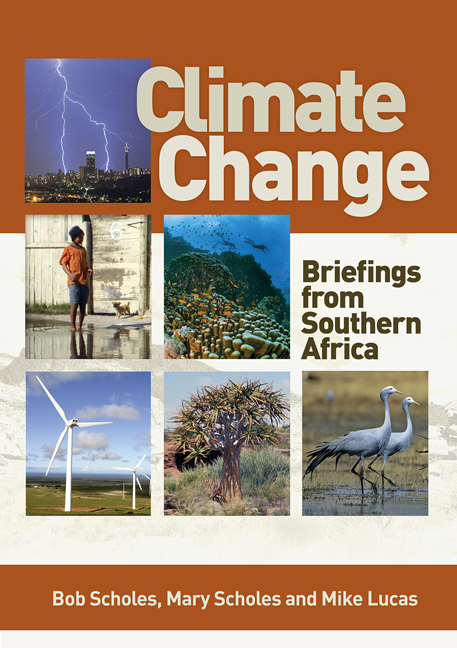Book contents
- Frontmatter
- Acknowledgements
- Contents
- Foreword
- Acronyms and abbreviations
- Preface
- How do governments assess climate change?
- Section 1 Earth system science: The processes that underlie climate change
- Section 2 Consequences of a changing climate for the Southern African environment
- Section 3 Consequences of a changing climate for society
- Section 4 What we can do to avoid and adapt to climate change
- Codicil Is there a dangerous level of climate change?
- Glossary
- List of figures
- References
- Reading list
- Index
Codicil Is there a dangerous level of climate change?
Published online by Cambridge University Press: 20 April 2018
- Frontmatter
- Acknowledgements
- Contents
- Foreword
- Acronyms and abbreviations
- Preface
- How do governments assess climate change?
- Section 1 Earth system science: The processes that underlie climate change
- Section 2 Consequences of a changing climate for the Southern African environment
- Section 3 Consequences of a changing climate for society
- Section 4 What we can do to avoid and adapt to climate change
- Codicil Is there a dangerous level of climate change?
- Glossary
- List of figures
- References
- Reading list
- Index
Summary
It is widely agreed that an average global warming of more than 3°C would be extremely dangerous worldwide. Even lesser degrees of global average warming (for example, 2°C) could be locally dangerous in South Africa, which warms faster than the global mean.
The stated objective of the United Nations Framework Convention on Climate Change (UNFCCC), which opened for signing in 1992 and was joined by various countries at various dates after that, is to keep global climate change below dangerous levels. This sparked an on-going scientific and political debate about how much climate change is dangerous. Dangerous to whom? Dangerous in what way? How much risk are we willing to take?
Many tens of thousands of people die every year from weather-related causes. The economic losses due to severe weather are rising sharply. The increase is partly because there are now more people on Earth, and they are living in more climatically exposed places with more infrastructure at risk. Proving that individual storms, floods and heatwaves are due to climate change rather than to natural climate variability is very difficult. But, statistically, it is highly probable that some deaths are indeed due to climate change. So, for these people at least, climate change has been fatally dangerous. However, it is likely that some people have been spared from freezing to death during severe winter since these are now, on average, more benign. We will never know for sure because proving something that didn't happen is harder than allocating responsibility for something that did happen.
Most people would agree that dangerous climate change is happening if their own lives, families, livelihoods and assets come under substantially greater climate-related risk than in the past. We also have sympathy for our fellow humans in other parts of the world, and feel concern for the fate of animal and plant species condemned to premature extinction due to climate change.
In some respects we have already crossed the threshold of dangerous climate change: species-rich ecosystems such as coral reefs and tropical forests are already under severe pressure due to climate change, and some species have gone extinct as a result (see Sec. 2, Q5 and Q14). The point where melting of the Greenland ice sheet is no longer reversible is in the foreseeable future.
- Type
- Chapter
- Information
- Climate ChangeBriefings from Southern Africa, pp. 176 - 178Publisher: Wits University PressPrint publication year: 2015



